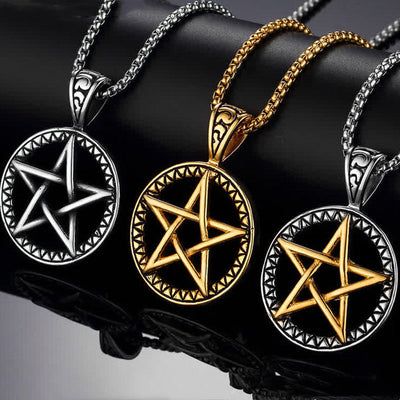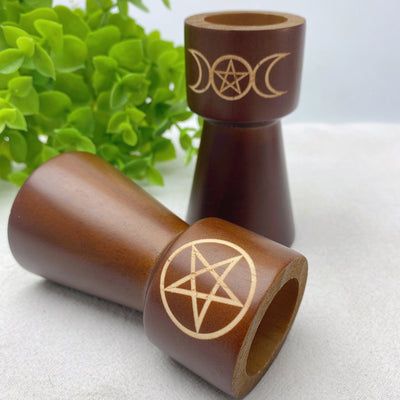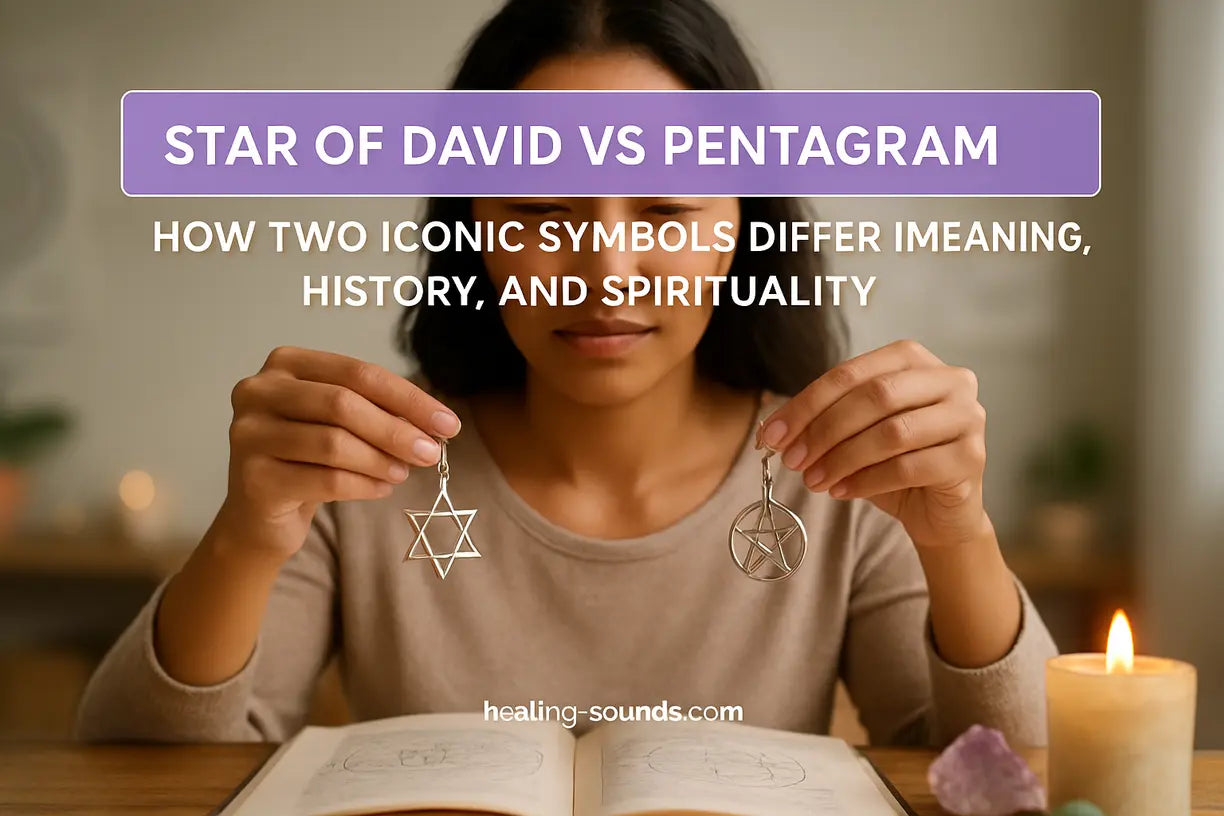In the vast world of spiritual symbolism, few icons are as recognizable—or as frequently confused—as the Star of David and the pentagram. While both are ancient star-shaped symbols rich with meaning, they come from vastly different historical and cultural backgrounds. Understanding the pentagram vs star of david is crucial for anyone on a spiritual journey, as it allows for a deeper appreciation of their unique power and significance. This guide will illuminate the distinct identities of these two powerful symbols, exploring their origins, meanings, and roles in modern spirituality.
Whether you're drawn to sacred geometry for meditation, seeking symbolic jewelry for protection, or are simply curious about ancient traditions, clarifying the difference between these stars is the first step. We will delve into their geometric structures, historical contexts, and the profound spiritual concepts they each represent, empowering you to connect with them authentically.
What is the Star of David? Unpacking the Hexagram
The Star of David, known in Hebrew as the Magen David (מָגֵן דָּוִד), which translates to "Shield of David," is the most widely recognized symbol of modern Judaism and Jewish identity. It is a hexagram, a six-pointed star formed by two interlocking equilateral triangles. One triangle points upward, and the other points downward.
Historically, its association with Judaism is more recent than many assume, becoming widespread in the 19th century. The symbol's power lies in its rich metaphorical meaning. The upward-pointing triangle is often said to represent humanity's aspiration toward God, while the downward-pointing triangle symbolizes God's divine grace reaching down to humanity. Together, they represent the covenant between God and the Jewish people and the perfect balance of opposites: heaven and earth, spiritual and physical, male and female. It is a profound emblem of unity, harmony, and divine protection.

What is the Pentagram? The Five-Pointed Star Explained
The pentagram is a five-pointed star, drawn with five straight strokes in a continuous, unicursal line. Its history is far older and more cross-cultural than the Star of David's association with a single faith. It has been used for thousands of years by various civilizations, including the ancient Mesopotamians and the Pythagoreans of Greece, who saw it as a symbol of mathematical perfection and truth.
In modern spiritual contexts, particularly within Wicca and other Neopagan traditions, the upright pentagram symbolizes the five essential elements. The four lower points represent Earth, Air, Fire, and Water, while the top point represents Spirit or the Self presiding over them in harmony. When enclosed in a circle, it is called a pentacle and is often used as a tool for protection, consecration, and personal balance. It embodies the concept of the human being as a microcosm of the universe, connected to all elemental forces.

Pentagram Titanium Steel Balance Necklace for Spiritual Calming
$26.90 $38.90
Wear this striking pentagram necklace for protection and daily balance, inspired by ancient symbology and modern style.
Explore ProductKey Differences: Star of David vs Pentagram Side-by-Side
While both are star symbols used for spiritual expression, their core characteristics are fundamentally different. A direct comparison of the star of david and pentagram makes these distinctions clear.
Visual & Geometric Distinction
The most immediate difference is their geometry. The Star of David has six points and is constructed from two separate, overlapping triangles. The pentagram has five points and is traditionally drawn with a single, unbroken line. This visual distinction is the easiest way to tell them apart instantly.

Cultural and Religious Roots
Their origins place them in separate spiritual streams. The Star of David is inextricably linked to Judaism and Jewish culture. In contrast, the pentagram has a more eclectic history, appearing in ancient Greek mysticism, Christian esotericism (representing the five wounds of Christ), and, most prominently today, in Wiccan and various pagan belief systems. For an authoritative look at its history, you can explore resources like the Britannica entry on the Star of David.
Core Symbolic Meanings
- Star of David: Represents the union of God and humanity, the covenant, divine protection, and the balance of opposing forces (heaven/earth).
- Pentagram: Represents the five elements (Earth, Air, Fire, Water, Spirit), the human body, protection, and the concept of "as above, so below" in a holistic sense.
Addressing Common Misconceptions
Much of the confusion between the pentagram and the Star of David stems from misinformation, especially regarding the pentagram. By tackling these myths, we can foster a more respectful understanding.
Is One "Good" and the Other "Bad"?
Absolutely not. The idea that the pentagram is an inherently "evil" symbol is a modern misconception, largely fueled by its use in horror films and its adoption by some groups to be intentionally provocative. In its traditional, upright orientation, the pentagram is a positive symbol of protection, balance, and elemental harmony. The Star of David is unequivocally a symbol of faith, heritage, and divine connection for millions. Context is everything.
Incorporating These Symbols into Your Spiritual Practice
Both the Star of David and the pentagram can be powerful allies in personal spiritual work, provided they are used with intention and respect for their origins. You can use them as focal points for meditation, place them on an altar to represent specific energies, or wear them as jewelry.
Wearing a pentagram or Star of David pendant allows you to carry its symbolic meaning with you throughout the day, serving as a personal reminder of balance, protection, or faith. Choosing a symbol that resonates with your path is a deeply personal and empowering act.

Enhance Your Practice with These Tools

Natural Hetian Cyan Jade Necklace & Bracelet Set for Luck
$26.90
{{ metafact_product_2_compare_price }}
This elegant set features pentagram motifs and jade, perfect for those seeking symbolic jewelry blending meaning and fortune. Learn more ➔

3.5 inch Wooden Candle Holder with Spiritual Engraving
$27.90
$39.90
Create a sacred space with this wooden candle holder engraved with the pentagram, ideal for rituals honoring star symbolism. Learn more ➔
Conclusion: Embrace the Symbol That Speaks to You
The debate of pentagram vs star of david is settled not by declaring one superior, but by understanding their distinct and separate identities. The Star of David is a sacred emblem of Jewish faith and heritage, symbolizing covenant and divine balance. The pentagram is an ancient, cross-cultural symbol representing the harmony of the five elements and is a cornerstone of many nature-based spiritualities. Both are beautiful, powerful, and deserving of respect. By learning their true meanings, you can confidently and consciously choose the symbols that align with your personal path to spiritual wellness and empowerment.
Frequently Asked Questions about the Star of David and Pentagram
The main difference lies in their points and origins. The Star of David has six points and is formed by two interlocking triangles, primarily symbolizing Judaism. The pentagram has five points, is drawn with a single continuous line, and is a cross-cultural symbol often representing the five elements in pagan and Wiccan traditions.
The pentagram is not mentioned explicitly in the Bible in the same way modern spirituality defines it. However, early Christians sometimes used the pentagram to symbolize the five wounds of Christ (on his hands, feet, and side). Its association with negative or satanic connotations is a much more recent development and is not reflective of its historical use in Christianity.
Yes. "Star" is a general geometric term. A pentagram is a specific type of star with five points. Other stars exist, like the hexagram (six points, e.g., the Star of David) or a heptagram (seven points). So, while every pentagram is a star, not every star is a pentagram.
An upright pentagram most commonly symbolizes the five classical elements: Earth, Air, Fire, Water, and Spirit (the top point). It represents harmony, balance, the human form (head and four limbs), and protection. When enclosed in a circle (a pentacle), it signifies unity and wholeness.
Yes, geometrically, the Star of David is a hexagram. The term "hexagram" refers to any six-pointed star shape. The Star of David is a specific type of hexagram formed by two overlapping equilateral triangles, which gives it its unique cultural and spiritual significance in Judaism.








1 comment
Israel/Derrick
So the five star as example might put one above or below the elements, such as Christian verse Satanist which one might also see often. While the Six pointed might also relate to Israel, Jews, Zion and/or Satanist (In some Christ Consider Context) perhaps. Thereby also Israel Star Point up and Down which might symbolize Judgement. While the five point stars might symbolize the direction of those beliefs such as Christians striving to go up and Satanist striving to go down. Just some thoughts on this as I’ve come to consider them. Then you have Tesla saying to understanding thing consider 3, 6, 9.. You might note the star of Israel is of Six. Three together might then be 6, 6, 6 which the world might imply Anti Christ, Beast, Satanist.. Also Alluding to Technology like Tesla and Technology Based in Modern Times perhaps. Then you might consider Father, Son and Holy Spirit denotes 3 and you could have the star trek symbol in a sense point up or down perhaps for direction as well, as to Heaven or Below. Then you have 9 to consider and such a thing as that. In Persian culture, the 9-Pointed Star was linked to the Zoroastrian faith, symbolizing the nine celestial bodies and their influence on human destiny. Might seem to point up and down separated in a sense. Hell or Abrahams Bosom maybe? Yet 3, 6, 9 also considering in a worldly capacity as frequencies and more. If only all hidden knowledge since the beginning of Man on earth was shared with all…